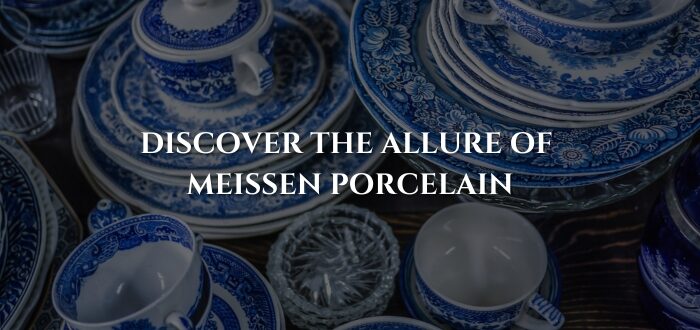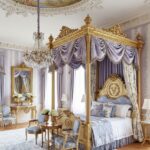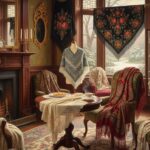Discover the Allure of Meissen Porcelain
In the 17th century, all of Europe was mesmerised by the Chinese porcelain. Porcelain also known as ‘white gold’ was the hallmark of luxury and elegance. From delicate porcelain vases to intricate porcelain figurines, these exquisite pieces adorned the palaces and salons of Europe’s royals and nobility. This was especially true for Augustus II the Strong, Elector of Saxony and King of Poland who established the Royal Porcelain Factory in Meissen.

The factory was created with the aim of producing porcelain that rivalled the finest Chinese porcelain. Meissen china, also known as Meissen porcelain, was first produced in 1708, and was prized for its exquisite craftsmanship, intricate designs, and high quality. This blog dives into the origin of Meissen porcelain, its different types including Meissen porcelain figurines, how to identify authentic Meissen porcelain and some of the most valuable Meissen figurines in the history of European decorative arts.
Also Read: Timeless Elegance of Imari Porcelain
The Origin of Meissen Porcelain
Before Meissen, Europeans were desperate to replicate Chinese porcelain, which had captivated royalty and merchants alike for centuries. The breakthrough came in the early 18th century when Johann Friedrich Böttger, unlocked the secrets of hard-paste porcelain.
Johann Friedrich Böttger was an alchemist and bragged that he could make gold. Hearing of this, the then ruler of Saxony, Augustus II, kept Johann in custody and asked him to prove his claim. Needless to say, Böttger didn’t actually produce any gold, but he did discover how to make hard-paste stoneware, which in turn led to creation of ‘true’ porcelain. Böttger’s discovery led to King Augustus the Strong founding a porcelain factory in the town of Meissen in 1710.
Types of Meissen Porcelain
-
Meissen Figurines
- The most iconic and sought-after pieces from Meissen are its porcelain figurines
- The idea of making small figures in porcelain came from the sugar ornaments (known as pièces montées).
- Many porcelain figurines were designed as table decorations.
- Highly collectible and sought-after figurines, often depicting mythological figures, animals, or everyday scenes, were a specialty.
Also Read: A Guide to Collecting Figurines

-
Blue Onion
The Blue Onion is a porcelain tableware pattern made up of several intricate floral motifs rendered in a rich blue colour on white porcelain. Common forms:
- Plates
- Bowls
- Teapots
- Porcelain vases
-
Meissen Tableware
Meissen produced elaborate tableware, including dinner services, tea sets, and serving pieces.
Meissen dinner sets often feature:
- Gilded rims
- Hand-painted florals
- Mythological scenes
-
Meissen Decorative Objects
Vases, bowls, and other decorative items were created with intricate designs and gilding.
-
Swan Service
The Swan Service, a grand dinner service commissioned by Count Brühl, one of the most famous high baroque production in Meissen Tableware.
How to Identify Meissen Porcelain
With so many imitations and reproductions in circulation, knowing how to identify Meissen porcelain is critical for collectors and investors.
-
The Crossed Swords Mark
Since around 1720, Meissen pieces have featured the famous crossed swords hallmark. Here’s what to look for:
Original mark: Two blue crossed swords, hand-painted under the glaze
Variations over time: Different styles were used in different eras
-
Quality of Painting and Glaze
Authentic Meissen pieces have:
- Immaculate brushwork
- Delicate, layered colours
- High-gloss, flawless glazes
- Details down to eyelashes and fingernails
-
Porcelain Quality
Genuine Meissen porcelain is known for its high quality. Early pieces may have a smoky white color, while later pieces are often a brilliant white.
-
Other Considerations:
- Weight and Feel: Handle the piece and assess its weight and feel. Authentic Meissen porcelain has a distinctive weight and texture.
- Period-Appropriate Features: Research the historical context of the piece and look for details that match the period.
- Consult Experts: If you’re unsure about a piece, consult with a reputable antique dealer or expert.
Most Valuable Meissen Figurines
Meissen’s figurines are not just decorative — they’re miniature masterpieces. Meissen porcelain figurines can fetch tens or even hundreds of thousands at antique auctions.
A Pair of Lovers with a Bird Cage
This charming figurine captures an intimate moment between a man and a woman locked in a gentle embrace. The man’s left hand rests on a delicate bird cage. Its detail, charm, and emotional expression make it a sought-after piece among collectors.

-
Harlequin: Commedia dell’Arte
Among Meissen’s most beloved figures is the Harlequin, a central character from commedia dell’arte, the popular 18th-century form of traveling Italian theatre. Harlequin, often portrayed as a sly trickster or jester, was frequently depicted mid-prank or in theatrical poses. His colorful costume and dynamic postures made him a favourite among both artisans and collectors.
-
Shepherd and Shepherdess Pair
This larger-scale figurine set features a shepherd and shepherdess, each playing musical instruments — the flute and the pipes. At their feet lie a loyal dog and a grazing sheep, creating a peaceful pastoral scene. These figures highlight Meissen’s ability to combine elegance with rustic romanticism.
-
The Genius of Johann Joachim Kändler
No list of Meissen figurines is complete without Johann Joachim Kändler, Meissen’s chief modeler from the 1730s to 1770s. He was the creative force behind many of Meissen’s most intricate and imaginative designs.
Notable Kändler figurines include:
The Monkey Band – A whimsical set of monkeys dressed in Rococo garb, playing various musical instruments. It remains one of the most collectible Meissen series ever made.
Parrot on a Tree Trunk – A vibrantly coloured parrot, captured mid-motion as it climbs upside down on a tree. The naturalism and sense of movement are signature Kändler touches.
-
Mythological Figurines:
Inspired by classical mythology, Meissen’s figurines of Venus, Apollo, Flora, and other deities were especially popular among European aristocrats. These figures often depicted gods and goddesses in dramatic, flowing robes with symbolic accessories.
As a rule, the larger and more complex the figurine — especially multi-figure compositions — the higher the value at auction
Why Collect Meissen Porcelain?
Provenance
Meissen has centuries of documented history and elite ownership.
Artistic Value
Each piece is handmade, hand-painted, and artistically driven, not mass-produced.
Investment Potential
High-end Meissen regularly appreciates in value, particularly rare figurines or signed pieces by Kändler.
Cultural Significance
Owning Meissen is like owning a piece of European history.
Tips for Buyers and Collectors
- Buy from reputable dealers or auction houses. Research them well before buying.
- Study hallmark variations for different production eras
- Look for documentation and provenance
- Avoid too-perfect sets — old porcelain should show age-appropriate signs
- Handle with care — chips or cracks heavily reduce value
The Lasting Appeal of Meissen Porcelain
Meissen porcelain continues to captivate collectors and porcelain enthusiasts alike. Whether it’s the whimsical charm of Meissen figurines or the refined elegance of a Blue Onion porcelain vase, Meissen remains a cornerstone of European decorative art.
Despite its centuries-old legacy, the Meissen factory has evolved with the times. In recent years, it has launched fresh collaborations with contemporary artists and designers, blending modern aesthetics with time-honoured craftsmanship. Yet, it remains firmly rooted in tradition—preserving the same meticulous techniques that built its global reputation.
Today, Meissen porcelain stands as a symbol of luxury, sophistication, and enduring elegance—just as it did in royal courts centuries ago.






